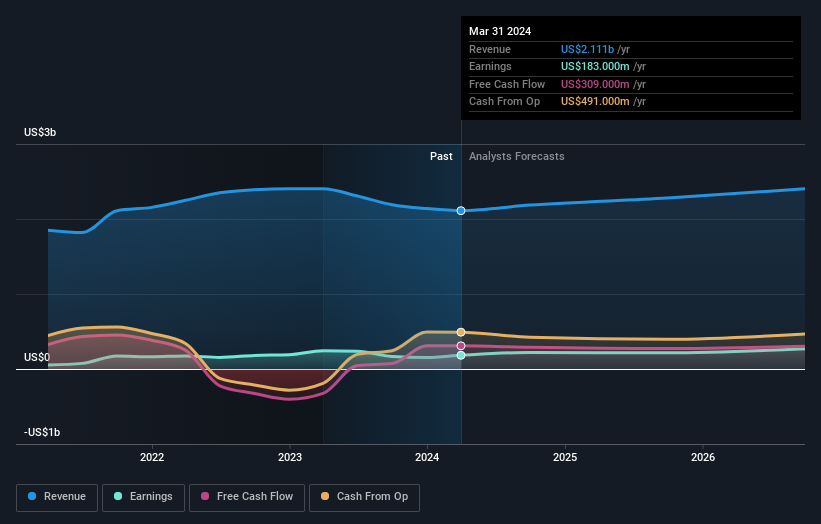- United States
- /
- Chemicals
- /
- NYSE:ASH
Ashland Inc. Just Beat Earnings Expectations: Here's What Analysts Think Will Happen Next

As you might know, Ashland Inc. (NYSE:ASH) recently reported its quarterly numbers. It looks like a credible result overall - although revenues of US$575m were what the analysts expected, Ashland surprised by delivering a (statutory) profit of US$2.39 per share, an impressive 169% above what was forecast. Following the result, the analysts have updated their earnings model, and it would be good to know whether they think there's been a strong change in the company's prospects, or if it's business as usual. We've gathered the most recent statutory forecasts to see whether the analysts have changed their earnings models, following these results.
View our latest analysis for Ashland

Following the latest results, Ashland's ten analysts are now forecasting revenues of US$2.19b in 2024. This would be an okay 3.5% improvement in revenue compared to the last 12 months. Per-share earnings are expected to step up 17% to US$4.26. In the lead-up to this report, the analysts had been modelling revenues of US$2.19b and earnings per share (EPS) of US$3.30 in 2024. Although the revenue estimates have not really changed, we can see there's been a considerable lift to earnings per share expectations, suggesting that the analysts have become more bullish after the latest result.
The consensus price target was unchanged at US$109, implying that the improved earnings outlook is not expected to have a long term impact on value creation for shareholders. The consensus price target is just an average of individual analyst targets, so - it could be handy to see how wide the range of underlying estimates is. The most optimistic Ashland analyst has a price target of US$126 per share, while the most pessimistic values it at US$90.00. There are definitely some different views on the stock, but the range of estimates is not wide enough as to imply that the situation is unforecastable, in our view.
Of course, another way to look at these forecasts is to place them into context against the industry itself. For example, we noticed that Ashland's rate of growth is expected to accelerate meaningfully, with revenues forecast to exhibit 7.1% growth to the end of 2024 on an annualised basis. That is well above its historical decline of 1.1% a year over the past five years. Compare this against analyst estimates for the broader industry, which suggest that (in aggregate) industry revenues are expected to grow 4.8% annually. So it looks like Ashland is expected to grow faster than its competitors, at least for a while.
The Bottom Line
The most important thing here is that the analysts upgraded their earnings per share estimates, suggesting that there has been a clear increase in optimism towards Ashland following these results. Happily, there were no major changes to revenue forecasts, with the business still expected to grow faster than the wider industry. The consensus price target held steady at US$109, with the latest estimates not enough to have an impact on their price targets.
Following on from that line of thought, we think that the long-term prospects of the business are much more relevant than next year's earnings. At Simply Wall St, we have a full range of analyst estimates for Ashland going out to 2026, and you can see them free on our platform here..
It is also worth noting that we have found 2 warning signs for Ashland that you need to take into consideration.
New: Manage All Your Stock Portfolios in One Place
We've created the ultimate portfolio companion for stock investors, and it's free.
• Connect an unlimited number of Portfolios and see your total in one currency
• Be alerted to new Warning Signs or Risks via email or mobile
• Track the Fair Value of your stocks
Have feedback on this article? Concerned about the content? Get in touch with us directly. Alternatively, email editorial-team (at) simplywallst.com.
This article by Simply Wall St is general in nature. We provide commentary based on historical data and analyst forecasts only using an unbiased methodology and our articles are not intended to be financial advice. It does not constitute a recommendation to buy or sell any stock, and does not take account of your objectives, or your financial situation. We aim to bring you long-term focused analysis driven by fundamental data. Note that our analysis may not factor in the latest price-sensitive company announcements or qualitative material. Simply Wall St has no position in any stocks mentioned.
About NYSE:ASH
Ashland
Provides additives and specialty ingredients in the North and Latin America, Europe, Asia Pacific, and internationally.
Good value slight.
Similar Companies
Market Insights
Community Narratives


